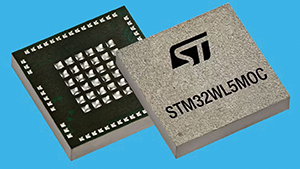

The STM32WL5M from ST Microelectronics is the company’s first LoRaWAN-certified module. This module is an update to the STM32WL5, which incorporated two cores, one of them being a wireless stack to optimise the creation of sub-GHz applications. The STM32WL5M integrates all components into one package to ease design and prototyping.
The STM32WL5M is ST’s first module to support two output powers, thanks to its two power amplifiers. Hence, coupled with the wide frequency range supported by its STM32WL5x, the module can work in Europe, the Americas, and Asia. Despite all this, however, the device is still one of the smallest at 10 x 10 mm. Consequently, the module makes designing a sub-GHz application far more practical, as it enables engineers to enjoy a comprehensive solution in a small package without having to deal with the complexity of creating it.
Why LoRaWAN?
In a survey presented at the 2017 International Symposium on Signals, Circuits, and Systems, researchers established that LoRa could solve the significant challenges that plague the widespread adoption of IoT devices. Its use of sub-GHz frequencies and its Chirp Spread Spectrum modulation technique enables the transmission of small packages over long distances, while making it more resilient against interferences, and more robust overall. According to the LoRa Alliance, there were more than 225 million LoRa/LoRaWAN end nodes in March 2022.
LoRa’s modulation stands up to interferences from electrical grids, and provides a methodology to optimise the implementation of smart meters. By embedding a radio, the STM32WL5 becomes an essential step toward democratising the Long Range technology and adopting more sustainable energy consumption.
Why do we need two cores?
Having two cores in the STM32WL5M avoids the hassle of re-certification with every update. If the network and applications stacks are on the same core, modifying any of it forces teams to re-certify the communication protocol. Thanks to the dual-core architecture of the STM32WL5M, developers sidestep this problem by putting the network stack on the Cortex-M0+ and the application on the Cortex-M4.
Another reason to provide a dual-core architecture is that is provides hardware isolation between each core. This enables authenticity verification, strong data decryption, and data integrity monitoring. The dual-core STM32WL5M also comes with many of ST’s STM32Trust features, such as secure firmware install and update. Additionally, it has two unique IDs (64-bit and 96-bit) to offer multiple protection levels against read and write operations.
| Tel: | +27 11 923 9600 |
| Email: | [email protected] |
| www: | www.altronarrow.com |
| Articles: | More information and articles about Altron Arrow |

© Technews Publishing (Pty) Ltd | All Rights Reserved